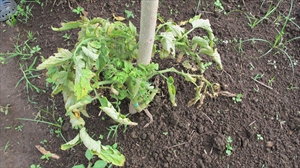Tomato - residual herbicide effects.
Pacific Pests, Pathogens, Weeds & Pesticides - Online edition
Pacific Pests, Pathogens, Weeds & Pesticides
Tomato - residual herbicide (379)
Papua New Guinea highlands, Fiji (possibly), and Vanuatu.
Tomato
Circumstantial evidence exists that tomato plants can be damaged by some herbicides that remain in the soil from previous treatments. Plants are yellowish, stunted, twisted and shoots are bunched (Photos 1-3).
Herbicides are often used on e.g., grasses to assist cultivation of land before planting tomatoes. Some of the herbicide will, inevitably, ends up in the soil. Usually, this residue breaks down very quickly, in days or weeks. In fact, there are regulations ensuring that herbicides do so.
However, there are situations where the breakdown is slow, and problems may occur. For instance, many products that contain glyphosate have a warning on the label to tell tomato growers of potential problems:
"[Product name] may be used for weed control in agricultural land prior to sowing any edible crop or non-edible crop, but not prior to transplanting tomato seedlings".
Problems may occur in sandy soils, low in organic matter, that may not hold onto glyphosate and where there is lower microbial activity; this means it is available in the soil and may be taken up by plant roots. It may be worse if rainfall is low or absent between herbicide treatment and planting. Adding phosphorous fertiliser to these soils can make the situation worse as phosphorous tends to release glyphosate from clay particles making it available again. The reason for this is that glyphosate contains phosphonic acid and this competes with phosphorus from binding sites on soil particles.
Because tomatoes are very susceptible to glyphosate, and glyphosate can remain in some soils, product labels have the warning given above. In some cases, the label will state that there should be a 3-day waiting period between the application of glyphosate and transplanting tomato seedlings. In some situations, this may need to be longer.
In 1990, it was reported in Australia that glyphosate (active ingredient 360 g/L, 4 L/ha) caused growth defects in tomatoes even when the interval between soil treatment and transplanting was 9 days, and possibly as many as 30.
A more recent study by NSW DPI also suggests that glyphosate, and its breakdown product AMPA, maybe longer-lasting in certain soils than previously thought, especially those planted to sensitive crops. After 40 days, half the amount of glyphosate applied was still present in the soil.
However, the significance of this result in terms of damage to tomato is still to be tested. Just because glyphosate can be identified in soil does not mean that it is available, it may be bound to soil particles.
Furthermore, some brands of glyphosate add other herbicides to make the residual effect longer. For instance, there are glyphosate products with added imazapic.
The impact of residual glyphosate on tomatoes is likely to vary a great deal. First, the type of soil, with tomatoes in sandy soils being the most likely to be associated with damage. Secondly, the amount of glyphosate applied to the soil. Different amounts are recommended for different weeds:
- For hard-to-kill perennial grasses (e.g., Guinea grass, Megathyrsus maximus var. maximus; Johnson grass, Sorghum halepense; kangaroo grass, Themeda australis; and kikuya grass, Pennisetum clandestinum) glyphosate is recommended between 2-4 L/ha (depending on the species).
- For easier-to-kill annual weeds, (e.g., thistles, wild oats, wild turnip, chickweeds, the rate is between 0.5-2 L/ha.
The concentration of glyphosate (i.e., its active ingredient), its rate and frequency of application, soil type, product (whether it is mixed with other herbicides), weather conditions, interval between the last application and transplanting of tomatoes, will combine to determine if there is an issue on plant growth and fruit yield.
Look for stunted plants with twisted, cupped, elongated leaves. Look to see if the youngest leaves are lighter green than normal, small and bunched. Note there is often variation between plants in a field, some with symptoms others healthy, which may indicate differences in concentrations of glyphosate in the soil or in uptake by the plants.
CHOICE OF SITE
- Avoid growing tomatoes where glyphosate has been applied frequently at high rates against perennial plants. If this is not possible, leave at least 40 days between the last application and transplanting tomato seedlings,
- Avoid growing tomatoes on land that has a history of regular glyphosate treatment and where residues may have accumulated in the soil.
- Ensure that glyphosate does not contain other herbicides that may increase its residual presence in the soil.
- READ THE LABEL CAREFULLY
- If unsure, carry out a bioassay as outlined below.
BIOASSAY
If tomatoes are to be grown in a field where glyphosate soil residues are a possibility, transplant a few test seedlings across the area prior to planting the entire crop. If residues are still present, symptoms should appear on the test plants within 7 days.
AUTHOR Grahame Jackson
Information from How much glyphosate? (2016) The Land. (https://www.theland.com.au/story/3792459/residual-roundup-not-what-you-think/); and Cornish PS (1992) Glyphosate residues in a sandy soil affect tomato transplants. Australian Journal of Experimental Agriculture 32: 395-9. (https://www.publish.csiro.au/AN/EA9920395); and from Herbicide residues in soils - are they an issue? Northern. GRDC. Grains Research Development Corporation, Australian Government. (https://grdc.com.au/resources-and-publications/grdc-update-papers/tab-content/grdc-update-papers/2016/02/herbicide-residues-in-soils-are-they-an-issue-northern).
Produced with support from the Australian Centre for International Agricultural Research under project HORT/2016/185: Responding to emerging pest and disease threats to horticulture in the Pacific islands, implemented by the University of Queensland and the Secretariat of the Pacific Community.






